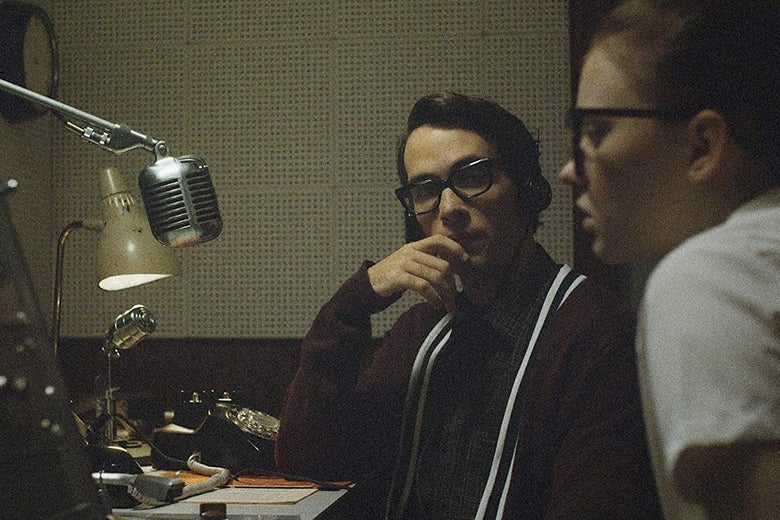
Jake Horowitz and Sierra McCormick in The Vast of Night.
Amazon Studios
Orson Welles, who knew a thing or two about making movies, reportedly remarked after touring the RKO lot that it was “the biggest electric train set any boy ever had.” And yet it is rare to see a feature film that communicates any of that delight, any of the sheer fun of playing around with the possibilities the medium offers. The Vast of Night, the debut feature from director Andrew Patterson and screenwriters James Montague and Craig W. Sanger, arriving on Amazon Prime on May 29, is one of the exceptions: Every scene has been staged and shot with intelligence, intent, inventiveness, and a sense of play. To watch it is to get excited about the billions of different ways you can combine sound and moving images to tell a story.
It is rare to see a feature film that communicates the sheer fun of playing around with the possibilities the medium offers.
That is not to say that you’ll necessarily be astounded by the story The Vast of Night is telling. Set in 1957, the film follows a radio DJ (Jake Horowitz) and a switchboard operator (Sierra McCormick) who become convinced that a UFO is prowling the skies above their tiny New Mexico town. It’s a tale as old as time, or at least as old as Roswell, and the film doesn’t move far beyond the plot conventions of its premise. Patterson announces his intentions in the very first shots, which frame the story as an episode of a Twilight Zone clone—complete with Rod Serling sound-alike—called Paradox Theater. But the film is not a pastiche: The content may be familiar, but the style is entirely Patterson’s own. It’s as if you asked someone who had never seen a UFO movie how best to shoot one.
Mostly, The Vast of Night works by carefully controlling the information the audience receives—not in terms of withholding secrets and supplying plot twists but in the volume of information on-screen at any one point. The opening, which follows Horowitz and McCormick’s characters Everett and Fay as they wander through a high school gym on the night of a big basketball game, is deliberately overwhelming: The dialogue is faster than a screwball comedy, the frame is packed with people in motion, the context clues are few and far between, and the entire scene is punctuated by the sound of rubber soles on hardwood. Once these characters leave the gym, though, Patterson’s camera clears away the clutter, giving us a couple of exceptionally long tracking shots following the protagonists walking down a country road at night. Although the conversation between them doesn’t slow down, it becomes manageable without the surrounding distractions, and the audience shares the characters’ relief at leaving the hot, sweaty crowd for a cool, quiet night. Later, Patterson takes this strategy much further: During a scene where a caller to Everett’s radio show is telling a story about a secret military project, Patterson fades to black and lets the audio do all the work. It’d be incredibly pretentious if it weren’t incredibly effective.
That kind of intrusive directorial voice can descend into showboating, especially when a director is doing too much instead of too little, and there are times when The Vast of Night feels a little like Patterson’s sample reel: a catalog of the things he can do with film, made primarily for the benefit of other people who might wish to pay him to do them in the future. He isn’t above calling attention to what he’s doing, either: “Don’t call me for 10 minutes. … Watch the clock now, 10 minutes,” Horowitz says in the midst of a shot that lasts for (nearly) 10 minutes. But that shot, a slow push-in on Fay working the switchboard as the calls coming in start getting weirder, is absolutely riveting. Like the audio-only section, it’s a reminder that an actor’s face, too, can be more than enough to tell a story.
Viewers who prefer a more aggressive kind of showboating are also in luck. After that 10-minute close-up, the very next shot is a five-minute-long roller coaster that starts on Fay lighting a cigarette outside her office, swoops inches above the ground across half the town to the high school, cuts through the parking lot, the gym, and the basketball game in progress, leaps through a window, glides through the other half of the town, picks up Everett lighting a cigarette outside the radio station, and ends on the phone on his desk as it begins ringing. And yet the sensation evoked is nothing like the “Wow! They pulled it off!” feeling most stunt shots of this sort aim for. The camera moves at an uncanny speed, faster than a human, slower than a car, and the score—noir horns over a driving rhythm, briefly drowned out by the sound of the basketball game—makes the whole thing even more ominous. There are simpler ways to transition between one location and another, just like there are more complicated ways to edit a scene of a woman working a switchboard, but in both cases, Patterson makes a pretty strong case that he’s chosen the best way. The Vast of Night is full of those kinds of big swings and unusual choices, executed with panache and impressive confidence. It’s an electric train set barreling through the night at full throttle.
from Slate Magazine https://ift.tt/3grfVni
via IFTTT
沒有留言:
張貼留言